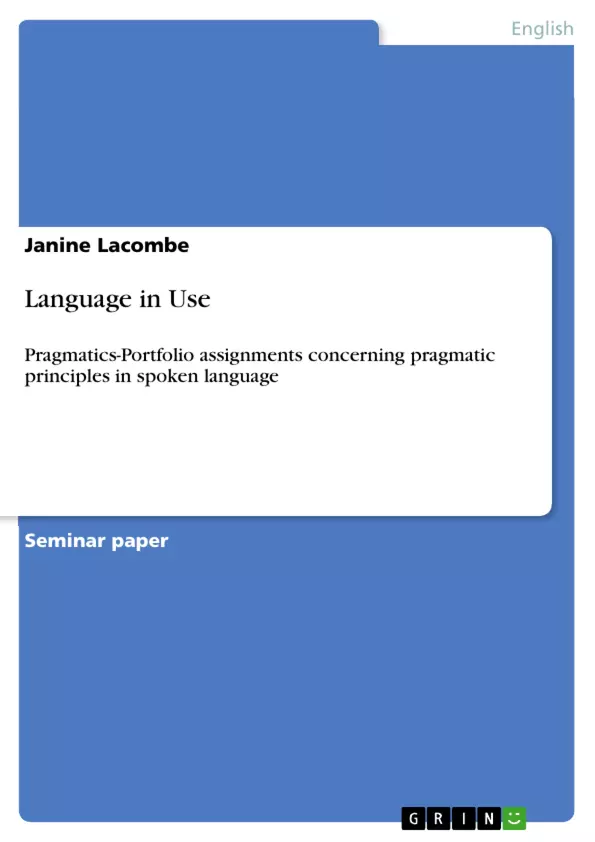Pragmatics-Portfolio assignments concerning pragmatic principles in spoken language. Includes study questions with complete answers.
Inhaltsverzeichnis (Table of Contents)
- (i) Towards the end of his introductory chapter, Levinson (1983: 31) offers the following definition of Pragmatics, which is in line with Gazdar's (1979) idea of context change: “Gazdar (1979: 4-5) ... wishes to capture the ways in which utterances change the context in which they are uttered: f(u) = c or f(s, c) = c i.e. f is a function from utterances to contexts, namely the contexts brought about by each utterance (or f assigns to each sentence plus the context prior to its utterance, a second context caused by its utterance).”. Discuss Levinson's definition by exploring the notion of context and its significance for the branch of Pragmatics.
- (ii) In How To Do Things With Words, Austin (1962) initially makes a very strict distinction between statements and performatives. This distinction, however, breaks down completely towards the end of his lecture. Illustrate the internal development of Austin's argumentation.
- (iii) Searle suggests a classification of speech acts - according to their illocutionary force - into representatives, expressives, commissives, directives and declaratives. Explain the differences between those five types of acts and find illustrative examples in real language use (i.e. spoken language corpora such as the spoken parts of the COCA or the BNC).
- (iv) In syntax, three kinds of sentences are distinguished depending on their structure: declarative sentences, interrogative sentences, imperative sentences. However, sentence type and illocutionary force are not always directly related. For instance, a request can be realized by means of an imperative (“Go away!”), an interrogative (“Would you mind leaving me alone for a while?”), or a declarative (“I would really like to be alone right now.”). Pick a film or TV series you like and find three examples of direct and three examples of indirect speech acts.
- (v) Illustrate the differences between maxim violation, maxim flouting and maxim hedging (Grice) with the help of concrete examples!
- (vi) well and now - Research question: Are well (286784 tokens) and now (285925 tokens) in their function as discourse marker interchangeable or do they serve specific functions in spoken discourse?
Zielsetzung und Themenschwerpunkte (Objectives and Key Themes)
This text aims to analyze and explore key concepts within the field of pragmatics, specifically examining the role of context, speech acts, and the nuances of language use. It delves into the ideas of various scholars like Levinson, Austin, and Searle, providing insights into the complex nature of communication. The key themes of the text include:- The concept of context and its impact on meaning and understanding
- The distinction between constative and performative utterances
- The classification of speech acts based on their illocutionary force
- The relationship between sentence type and illocutionary force
- The different ways in which conversational maxims can be violated or manipulated
Zusammenfassung der Kapitel (Chapter Summaries)
(i) Towards the end of his introductory chapter, Levinson (1983: 31) offers the following definition of Pragmatics, which is in line with Gazdar's (1979) idea of context change: “Gazdar (1979: 4-5) ... wishes to capture the ways in which utterances change the context in which they are uttered: f(u) = c or f(s, c) = c i.e. f is a function from utterances to contexts, namely the contexts brought about by each utterance (or f assigns to each sentence plus the context prior to its utterance, a second context caused by its utterance).”. Discuss Levinson's definition by exploring the notion of context and its significance for the branch of Pragmatics.
This section explores Levinson's definition of pragmatics, highlighting the significance of context in understanding meaning beyond semantic content. It emphasizes the dynamic nature of context, how utterances can alter the communicative situation, and the role of pragmatic information in interpreting speaker intentions.(ii) In How To Do Things With Words, Austin (1962) initially makes a very strict distinction between statements and performatives. This distinction, however, breaks down completely towards the end of his lecture. Illustrate the internal development of Austin's argumentation.
This chapter examines the development of Austin's argumentation regarding performative utterances. It analyzes his initial distinction between constative and performative statements, illustrating how this dichotomy breaks down as he encounters more complex cases that defy clear categorization.Schlüsselwörter (Keywords)
The main keywords and focus topics of this text are: pragmatics, context, speech acts, illocutionary force, performative utterances, constative utterances, conversational maxims, maxim violation, maxim flouting, maxim hedging, discourse markers, spoken language corpora, spoken discourse. These terms represent the central themes and concepts explored within this academic study of language use and communication.
Ende der Leseprobe aus 26 Seiten
- nach oben
- Arbeit zitieren
- Janine Lacombe (Autor:in), 2014, Language in Use, München, GRIN Verlag, https://www.hausarbeiten.de/document/278799
Blick ins Buch


